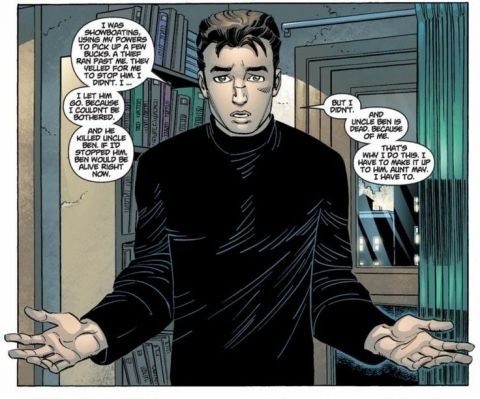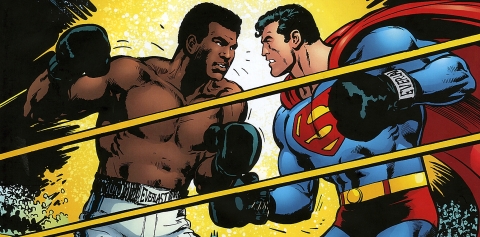When the New 52 rolled around for DC Comics, the comic publisher used the relaunching of all of their comic related properties to instill from fresh blood into most of their series. Jeff Lemire would spearhead the relaunching of Animal Man and Frankenstein, Agent of S.H.A.D.E., as well as taking over Justice League Dark shortly thereafter. Several months later, Lemire would get the assignment to write Green Arrow in an attempt to salvage the character whose series had been critical panned since the New 52 had begun. The attempt was a success as Lemire gave the character a much-needed injection of adrenaline, excitement and strangeness that would help propel his run with the character forward as a fan favourite.
Green Arrow Volume 4: The Kill Machine
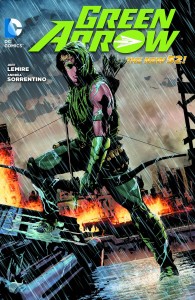 Oliver Queen is torn down at every turn in this story as he is stalked by a series of new foes who he is woefully unprepared to face. Emerson, Oliver’s father’s best friend and the man in charge of Queen Industries, loses the company to rivals Stellmoor International, enraging Oliver over the loss his future company. As Oliver confronts Emerson he begins to discover that his future was shaped for him long before he ever could’ve known. Emerson is assassinated by an unknown archer as the two men speak and Oliver is seemingly framed for murder. Fleeing the scene, Oliver tries to contact his two partners, Jax and Naomi, at Q-Corp to help him try to clear his name only to watch the Q-Corp building explode in the middle of their conversation. Wanted for murder with no one in his corner, Oliver must act quickly as the Green Arrow to try and clear his name and discover why someone is targeting him on such a personal level.
Oliver Queen is torn down at every turn in this story as he is stalked by a series of new foes who he is woefully unprepared to face. Emerson, Oliver’s father’s best friend and the man in charge of Queen Industries, loses the company to rivals Stellmoor International, enraging Oliver over the loss his future company. As Oliver confronts Emerson he begins to discover that his future was shaped for him long before he ever could’ve known. Emerson is assassinated by an unknown archer as the two men speak and Oliver is seemingly framed for murder. Fleeing the scene, Oliver tries to contact his two partners, Jax and Naomi, at Q-Corp to help him try to clear his name only to watch the Q-Corp building explode in the middle of their conversation. Wanted for murder with no one in his corner, Oliver must act quickly as the Green Arrow to try and clear his name and discover why someone is targeting him on such a personal level.
Like with most of my posts, I use the first paragraph about the book to give a general plot summary with minimal spoilers. Everything I just described happens within the first ten pages of issue one and it most certainly doesn’t stop there. That’s a lot of story to happen in the first ten pages of Jeff Lemire’s run with Green Arrow, let alone any comic book, but boy do they set the tone for what is one of the best superhero stories I’ve read in a while. It seems a little weird to look at a series starting with the fourth volume in the collection (issue 17 if we’re going just based off an issue number) but there is no better spot to jump on to Green Arrow in the New 52 than when Jeff Lemire’s time with the character begins. There isn’t any way to tip-toe around it, the first three volumes of the New 52 Green Arrow just aren’t that good. They’re not entirely awful, but they could be better. Jeff Lemire’s time with the character is a breath of fresh air as he leaves an odd, tribal like staple on the series that pushes the character into a direction that he’s never been taken before.
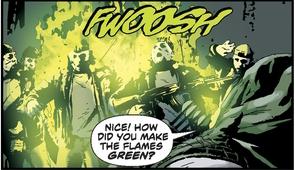
With a character like Oliver Queen, Jeff Lemire has to try and find the balance between the badass vigilante and the spoiled brat persona that Oliver uses to shield himself from public perception. Although there are plenty of “holy crap that was so awesome I can’t believe archery related heroes could be this cool!” moments, Lemire still seems to favour whiny and brash Ollie instead of a wise and well equipped one. It’s not a bad thing whatsoever though, as it balances it out fairly well in that you get a good portion of the heroic side of Ollie as well as the side that just get beat down repeatedly. The best superhero stories tend to be the ones where you take everything from the hero and build them back up, with this story being a great example of that. As I said above, in the first ten pages Lemire takes away any safety nets that Ollie already has in place. He strips him on his allies, his freedom and ultimately his equipment, ripping the character down to his core so that he’s forced to rebuild. Watching how Ollie pulls everything back together to try and triumph is what makes this one fun, as you never really know what direction things will turn to get where they need to be.
The most fascinating part of this story is easily the tribal elements that Lemire introduces to the Green Arrow mythos. Here Lemire toys around with the ideas of Ollie’s destiny and how becoming the Green Arrow might have been something he was being built up to do for his entire life. Lemire introduces the seven clans that create “The Outsiders”, a group of people who each wield a different weapon that allows them control over their respective clan; whoever wields said weapon will experience true enlightenment. It’s the way Lemire takes these ideas and contorts them into something new that will fascinate fans of Green Arrow new and old. The Outsiders were a fairly popular team of characters sometimes containing heroes or villains, but here Lemire turns them into an almost mystical tribal entity that isn’t your norm for superhero comics. Another great twist on the Arrow mythos is the inclusion of some other popular characters from Green Arrow’s mythos. Lemire includes more than a few characters who have close personal ties to the character and it is the way Lemire tweaks these characters with interesting new spins that will keep readers coming back for more.
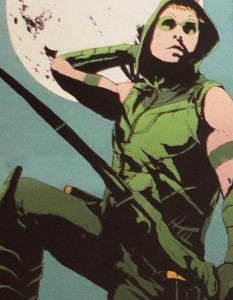
The entire idea of the clans and The Outsiders weaves into our primary antagonist, The Komodo, who terrorizes Green Arrow for the first half of the volume. Komodo is a superior archer to Oliver and showcases that at every opportunity he gets, seeking to eliminate him so that he can take his rightful place at the head of the Arrow Clan. The repeated showdowns these two men have during the first half of the story are equally exhilarating and terrifying, capping off with a brutal finale about halfway through the book. The secondary antagonist is a longtime Green Arrow foe, Count Vertigo, re-imagined here for the first time in the New 52. You get a great glimpse into what makes his character tick during the special #23.1 issue that hones in on why Vertigo is the way he is. It’s a sick, dark tale that only further compliments the narrative of the back half of the story.
Lemire’s partner for his entire run is Andrea Sorrentino, with whom this book just might not have felt the same. As you read through the story you notice two things. One: Lemire manages to pack a lot of story on to the pages without it feeling overly wordy or bogging you down. Two: Sorrentino’s artwork is absolutely killer and one of a kind. The heavy amount of panels used by Sorrentino during conversational parts of the story come off as beautiful instead of boring simply because of the way he structures the page, cutting in an action into a smaller panel that falls between the panels where people converse. Look to page three of the first issue in this volume to see a perfect example of what I’m referring to. Sorrentino uses thirteen panels (13!!!!) on one page to tell a story and it is the perfect amount needed. He has an art style that is as awesome as it can be trippy and it is the use of these smaller panels that just elevates this book that much higher above any competition it faces.
With all the bold and interesting new ideas there are bound to be some things that just don’t mesh well in this story right? Wrong. In all honesty there’s only one part of the story that really caught my eye as being something worth noting as a problem and it was just the overuse of the word “damn”. Lemire packs the word “damn” into the story time and time again to the point where it feels like you see it five or six times during the first issue and then repeatedly at different intervals for the rest of the story. Just to have Oliver say damn so many damn times in the damn story really takes you out of the damn moment. See what I mean? But beyond that, this story felt rather flawless and sets up a larger storyline that is carried on through another volume and presents what I would argue is the best vigilante/superhero work of Jeff Lemire’s career.

Collects: Green Arrow #17-24, 23.1.
Best Character: Oliver Queen/Green Arrow.
Best Line Of Dialogue/Caption: “Ahh…don’t feel bad Fyff–your green flamey arrows are neat, too.” – Naomi.
Best Scene/Moment: The graveyard fight – Issue 20.
Best Issue: Issue 20. This volume is broken down into two different arcs, with Issue 20 serving as the fourth part to the arc “The Kill Machine”. This issue doesn’t conclude that storyline but if it did, the reader could feel satisfied with what they take away from it. You’ve got a moody, climatic fight scene staged in a personal setting for Oliver Queen, a race against time and an ending that sets up the conclusion of the arc convincingly. You can’t help but credit Lemire and Sorrentino for scripting out a fight scene that eats up most of the issue yet doesn’t get boring. The action is taut, brutal and all kinds of awesome as this issue just showcases why their run with Green Arrow is as good as it is.
Why You Should Read It: This volume is just a different type of vigilante goodness that you won’t find from superheroes like Daredevil or Batman. Lemire takes ideas from previous Green Arrow stories and contorts them into intriguing concepts for the New 52. Green Arrow: The Kill Machine is a fine example of a writer and artist clicking to tell a strange but rewarding story. If that isn’t enough for you than just rest assured that this volume is the moment where the New 52 Green Arrow truly finds his footing. The writing is on point, the artwork is unique and incredible…how many other reasons do I need to give you?
The Collected Essex County
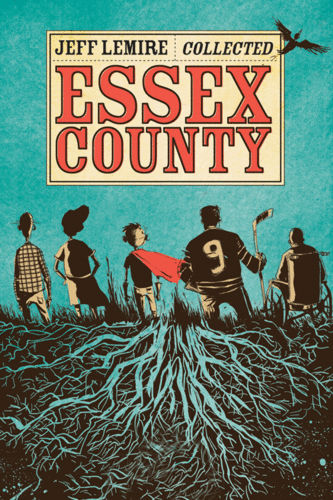 When speaking about popular Canadians authors in the comic industry, one doesn’t have to wait long to hear Jeff Lemire’s name pop up into the conversation. Lemire, born and raised in a farming town in Essex County, comes off as being so Canadian that it wouldn’t surprise me if the man bled maple syrup. An accomplished comic writer as well as an illustrator, Jeff Lemire has found a multitude of success across several different comic publishers ranging from the big guns like DC Comics to self-publishing under his own Ashtray Press imprint. As a proud Canadian it is always just a joy to see another proud Canadian who pours their heritage into every ounce of their work. Today’s book, Essex County, is a defining example of Lemire’s love for his heritage as he writes and illustrates the entire affair in such a way that you might be singing the national anthem by the time you’re done your first reading of it.
When speaking about popular Canadians authors in the comic industry, one doesn’t have to wait long to hear Jeff Lemire’s name pop up into the conversation. Lemire, born and raised in a farming town in Essex County, comes off as being so Canadian that it wouldn’t surprise me if the man bled maple syrup. An accomplished comic writer as well as an illustrator, Jeff Lemire has found a multitude of success across several different comic publishers ranging from the big guns like DC Comics to self-publishing under his own Ashtray Press imprint. As a proud Canadian it is always just a joy to see another proud Canadian who pours their heritage into every ounce of their work. Today’s book, Essex County, is a defining example of Lemire’s love for his heritage as he writes and illustrates the entire affair in such a way that you might be singing the national anthem by the time you’re done your first reading of it.
Essex County is a Goliath sized collection of the Essex County trilogy, created by Jeff Lemire in 2008 and 2009. As the story is a trilogy, it is broken down into three separate books that follow a different character’s story every time. Tales From the Farm, Ghost Stories, and The Country Nurse all tell the stories of three different individuals as well as the people who surround them while they remained tied to Essex County. Tales From the Farm follows a ten year old boy named Lester, a superhero obsessed, comic loving kid whose head remains in the clouds. Lester lives with his uncle Ken following the tragic loss of his mother. In need of a friend, Lester befriends Jimmy LeBeuf, a slow and brutish looking man with a tender heart. Ghost Stories touches on the lives of the LeBeuf brothers, Vincent and Lou, who both had dreams of making it to the NHL as they played their way together through the lower levels together. The Country Nurse follows Anne Byrne as she travels around Essex County as a nurse, helping those in need and revealing the ties that bind much of Essex County together.
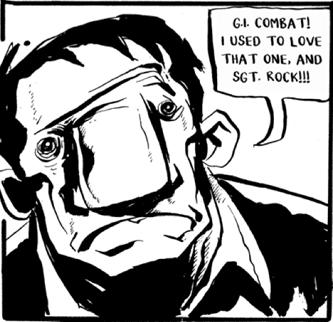
All that really needs to be said about Essex County is that it is a beautiful book. I could stop my analysis of it with this current sentence and feel content with trying to get my point across. There’s a beautiful simplicity yet still an overarching sense of complexity that my words just won’t do justice to for this book. I’ll try my damnedest though. The true beauty of Essex County lies in the roots of the story, Jeff Lemire’s roots, as he gives you a breathtaking display of what makes Essex County so amazing through these characters. It feels wrong to say “these characters” though because, in reality, the setting of Essex County is just as much a character in this book as anyone else is. With every page Lemire illustrates the nature of Essex County, as there is barely a page set in that locale that doesn’t look like a rural farming city. It’s a stationary location yet you can still see it breath and become emotive just like the other functioning characters on the page. The setting is the key to the entire story as it is what ultimately serves as the tie that keeps every character connected to each other.
The characters here will likely all tug on your heart-strings but none so more than three of the main characters in Lester and the LeBeuf brothers. Lester faces tragedy at such a young age in this story and the way Lemire presents these events just tears away at you, choosing to set the story in the present but still cut away to the past to show us what Lester has lost. He’s lonely and hollow in ways that no ten year old boy should be, as evidenced by his stoic nature and lack of words. Lester’s silence is such a powerful thing in this story as, although he speaks plenty, it’s Lemire choice of when allowing Lester to speak that truly speaks volumes. His choice of making the character really only pipe up when necessary gives great weight to Lester’s every spoken word. To see how this lonely boy’s shell cracks when given a true and unexpected friend is the best part of the entire first book, as we watch the strength of the reluctant relationship formed between Lester and Jimmy LeBeuf.
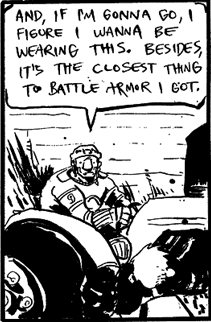
With the LeBeuf brothers you get a story that seems to not be connected to Lester’s at all for the first two chapters or so. Their story feels a little random because of how far into the past it reaches but that doesn’t take away from everything being told. Instead it builds a broad sense of history that you can’t look away from. Lou LeBeuf serves as the primary narrator for the second book of the trilogy, as we see the relationship he dearly holds with his brother Vincent or “Vinnie” for short. In the present day we see a miserable and disgruntled old Lou who is constantly reminiscing about the days gone by. He misses the time he shared with his young, mammoth of a brother. He misses his dreams of making it to the NHL. Lou’s story is just another instance of how tragic the tales in Essex County can be as you see a (for lack of a better current term) “pathetic” old man who desperately clings to his lost years as his best days are behind him. Cutting between the earlier years of Lou’s life and then transitioning back to the present day only twists the knife more as the flipping narratives show you the slow decline of Lou’s life and all he holds precious. If “Tales From the Farm” was the choked up feeling you get in your throat before you cry, then “Ghost Stories” is the uncontrollable sobbing that follows shortly after.
The story feels like it is told in all kinds of weird manners as the norm for telling stories is to do so in chronological order. Essex County does nothing like that, telling the story in whatever manner it feels will deliver the most impact to the reader. Rest assured that Lemire guides the story in the perfect direction to elicit all different types of feelings from you. At no point will you feel confused or lost in what’s going on. Actually I should correct that last sentence because you do get lost at points but in a positive way. You get lost in a tragically heartwarming story about the importance of community and family. The true downside to Lemire’s Essex County isn’t a flaw with a character or story, it is that it ends when it feels like it’s a story that could go on forever.

Collects: The Essex County Trilogy (Book One: Tales From The Farm, Book Two: Ghost Stories, Book Three: The Country Nurse), The Essex County Boxing Club, The Sad and Lonely Life of Eddie-Elephant Ears, Barnyard Scraps: Bonus Materials
Best Character: Lou LeBeuf.
Best Line Of Dialogue/Caption: “It’s sort of like drifting in and out of a nap…moments of clarity still come…My mind will snap to attention and I’ll know who I am, and where I am, just as clear as I ever did.” – Lou LeBeuf.
Best Scene/Moment: The moment where it all ties together – Book Three: The Country Nurse.
Best Issue: Book Two – Ghost Stories. Ghost Stories makes up over half of the Essex County Trilogy and features the heaviest hitting moments of the entire story as you watch a senile old man try to grasp at the life he’d already lost long ago. He’s afraid of ending up alone yet that’s the very place he ends up because of his own actions. Part of you wants to hate the man but another part of you just feels sorry for him because of how pathetic he comes off at times. The entirety of Book Two breaks your heart and puts it back together time and time again, emotionally exhausting you as you claw to the end of a tale about bonds and betrayal. When you’re done reading this volume, there’s a strong chance that you’re going to go hug your nearest loved one or pick up the phone just so you can hear the voice of someone you care about.
Why You Should Read It: There’s a reason this book is considered an important piece of Canadian literature. If you read it, I’m sure you’ll come up with your own reason why. For me, it all has to do with the fact that the setting is a character itself and how Lemire handles all of these characters. These are all personal stories that feel like they’re true stories and that might be because they are. Maybe they didn’t happen this way exactly or to these people with these names but there’s no way that other people on this planet haven’t felt or experienced the things that these characters go through in Essex County. You should read this because it’s a book that as honest as it is heartbreaking and beautiful. In many regards I believe it isn’t meant to be a tragedy and instead it’s meant to instill a sense of hope as well as remind us why family is so important. The book isn’t sad when you read it but then when you stop and think about it, there are plenty of parts that just hit you in the right way if you relate to what some of these characters have been through.


